There's a lot here, so I'll try to take it a piece at a time.
123Sam123 said:
Thanks a lot for helping, soon I can give exact Ph and ammonia levels. When cleaning the standard foam, I literally just get maybe 4-5 jugs of aquarium water and pour it over the foam. I also rub it with my fingers to get rid of remaining muck. With the carbon media I do the same, but with more jugs of water. I replace the carbon media every 2-3 weeks, and the standard foam every 1-2 weeks. I don't clean the bio media, as instructed by the CF40 manual (Obviously to keep the good bacteria intact).
Glad to hear you aren't changing out everything in your filter each water change and that you are using aquarium water. This relieves my biggest concern that you were causing the tank to cycle and recycle constantly. The bio media will hold a fair amount of bacteria, but it won't hold ALL of it. So, every time you are removing the sponges, foam, carbon, etc. you are removing bacteria from your tank. It is best to replace this ONLY when the material is literally falling apart. If this is in good shape, there's no need to replace it. A good rinse is all that would be necessary.
Carbon itself is NOT required in the filter full-time. It is great for removing unwanted chemicals from the tank (like after a course of medication is used), but is definitely not something worth the expense of replacing constantly! Just add some extra sponge, foam or 'bio' media. Keep a supply of carbon on hand for emergency use after a course of medication, but I'd recommend using it ONLY for that.
You had mentioned the gravel didn't usually get a vacuum as the food didn't lay there, but the fish ate it all. This is a bad habit, I'm sorry to say. As I mentioned before, goldies are messy fish (lovely, but messy) and produce a LOT of waste. At higher temps they produce even more. This waste (poo!) needs to be removed as it is a source of extra ammonia in your tank.
25% water changes weekly in an overstocked tank just isn't enough, and you are likely dealing with excessively high nitrates if not actually dealing with ammonia. The high nitrates ALSO cause problems with the long term health of your fish, which again could be an indication of why you haven't seen these problems much in the past. And the longer the fish are in the tank, the more waste products build up in the bottom of the gravel. The very bottom of the gravel is likely a disgusting mess that you'd be shocked to see.
123Sam123 said:
Do you have any idea why my water snail floats around a lot, or why my loach plays dead for ages, floating at the top, then sinking back down?
Also I isolated the pearl scale, and are going to buy a Interpet Mini PF Internal filter for it. I have got some FLUVAL treatment to reduce chlorine/ammonia/nitrite levels in the water. Is there anything else I should be adding to the water?
Thanks again, Sam
No clue about the snail or loach behavior. There's generally no need to add much of anything to the water other than a quality dechlorinator.
123Sam123 said:
How can I reduce the tank temperature, without making radical changes?
There are multiple ways:
- Open the lid of the tank (if practical, some fish are jumpers) and have a fan blow over the surface. The increased evaporation will lower the temp.
- Water change. Add water at a slightly lower temp (slowly) to the tank and the overall temp will drop.
- Ice water bottles. Float a few water bottles that have been stored in the freezer for a while. This will slowly lower the temp of the tank as the ice melts, and the bottle will safely allow you to use ANY kind of liquid, though aquarium water is safest!
123Sam123 said:
Is there any particular treatment I need?
Until we know for certain if it is or isn't columnaris, the only treatment I'd recommend is LOTS of fresh water. Its actually amazing how much fish can overcome on their own when their water is clean. Their immune systems are pretty good. And until we know what the actual water stats are... water changes and lots of them is the best course of action at this time.
This will serve multiple purposes:
1 - This will lower the temperature, as water from the tap should be closer to ground water temps than the water in the tank.
2 - This will lower ammonia, nitrite, nitrate or whatever else is in too high a concentration in the tank.
3 - This will provide clean water to give the fish a chance to deal with the problem themselves.
An option that you certainly could use on the fish with the lesion until you get a better ID on the exact problem would also be a 'fish dip/salt bath'. I'll link a resource to go over how to do that. If the problem is columnaris, fungus, or just about any type of external parasite, this will help, as it is often recommended as a supplement for medical treatments.
This should ONLY ever be done with fish that can tolerate salt!!!
http /www.aquarium-pond-answers.com/2009/07/fish-baths.html
/www.aquarium-pond-answers.com/2009/07/fish-baths.html This is a great resource. BTW, goldfish CAN tolerate salt, so you don't need to worry about that. Just be VERY watchful for the first one. You could do up to two or three of these each day, as the fish tolerates. IF the fish EVER turns sideways, return it to the main tank IMMEDIATELY!
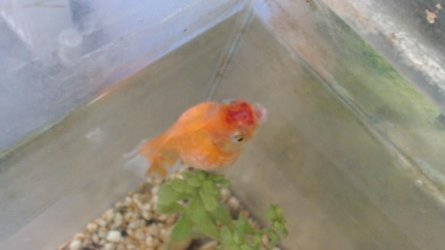
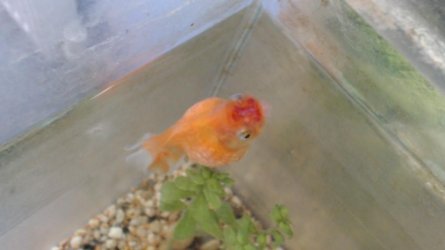
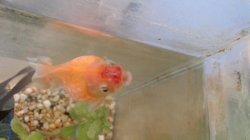




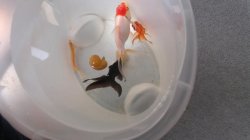



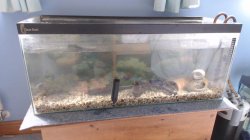
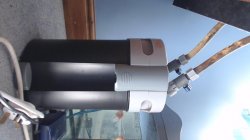
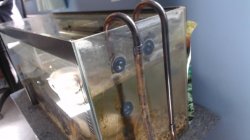

 /www.blueridgekoi.com/columnaris-diagnosis-treatment-2/
/www.blueridgekoi.com/columnaris-diagnosis-treatment-2/